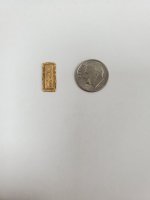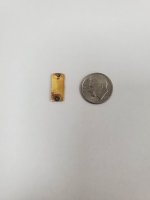Good afternoon everyone.
While on lunch break today I went detecting out in the woods. Halfway through I hit a lower tone on the equinox and thought it was a bullet. Instead this pops out about 4 or 5 inches down and was shiny. I thought it was brass but after cleaning it, it feels heavier than brass. It looks like it was soldered onto another peace at one point.
Thanks for looking
While on lunch break today I went detecting out in the woods. Halfway through I hit a lower tone on the equinox and thought it was a bullet. Instead this pops out about 4 or 5 inches down and was shiny. I thought it was brass but after cleaning it, it feels heavier than brass. It looks like it was soldered onto another peace at one point.
Thanks for looking
Amazon Forum Fav 👍
Attachments
Upvote
22









